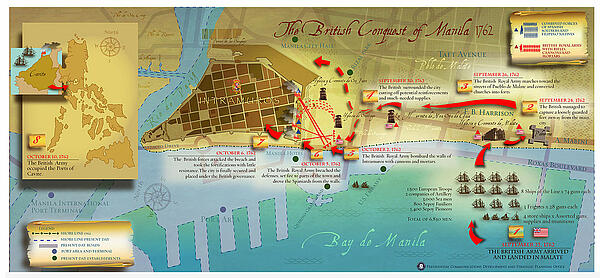The British invasion
At the time of Charles III’s ascension to the Spanish throne (August 1759), Great Britain and France were embroiled in the Seven Years’ War. Having suffered a number of setbacks in battles, France managed to negotiate a treaty with the new king - the Family Compact - which was signed in August 1761 and stated that Spain had to prepare for a war against Britain.
Determined to counter the Spanish hostility, the British quickly targeted Spanish-colonised Philippines and in 1762 they arrived in Manila. The British Empire was particularly seeking to use the city as a hub for trade with Asia, and China in particular.
The British fleet arrived in September 1762 and the expedition, led by Brigadier-General William Draper and Rear-Admiral Samuel Cornish, captured Manila quickly. Much of their ease was dye to the death of Governor-General of the Philippines Pedro Manuel Arandia, who was eventually replaced by Archbishop of Manila Manuel Rojo del Rio y Vieyra. This led to many mistakes being made during the attacks, resulting in the British repeatedly taking command of key landmarks in Manila.

Once Manila had fallen to the British, they set their sights on other important settlements around the islands. In the end, the Spanish-Filipino forces managed to keep them confined to the single region, but the British still managed to cause significant damage and even secured a ransom and written surrender from Rojo on 30th October 1762.
In spite of the apparent surrender, Don Simón de Anda y Salazar, who was dispatched by the Royal Audience of Manila to defend the city against the British, rejected the action as illegal. In fact, he claimed the title of Governor-General for himself under the statutes of the Council of the Indies and led Spanish-Filipino forces that kept the British troops under control. In addition, he managed to redirect the Manila galleon trade so the British couldn’t capture the ships or the products that were on board. This quickly led to desertion within the British ranks and placed the expedition in a difficult position.
On 10th February 1763, the Seven Years’ War was ended by the Peace of Paris treaty, which dictated which lands belonged to which kingdom. While overseen by Portugal, the treaty was primarily signed by France, Spain and Great Britain, who agreed that all lands not specified would fall under Spanish control. However, the signatories at the time were unaware that the British were in control of Manila. As a result, the Philippines were ignored in the treaty and were left to the Spanish Crown. Anda quickly enforced the agreement and the British were forced to withdraw from the archipelago.
MLA Citation/Reference
"The British invasion". HistoryLearning.com. 2025. Web.
